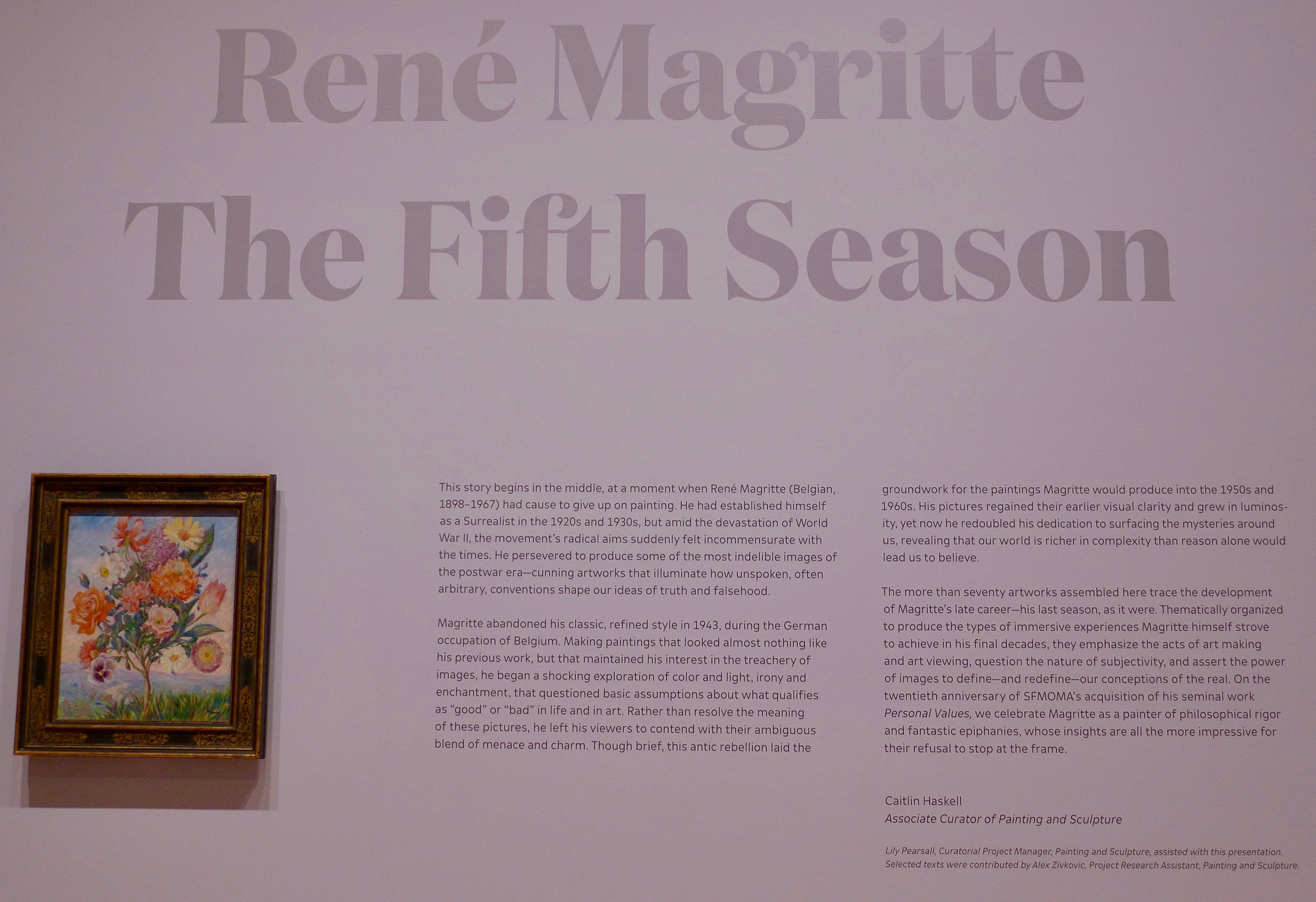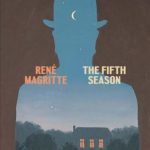
A curious children itinerary for a playful exhibit…
René Magritte: The Fifth Season is the first exhibition to focus exclusively on the artist’s late career, from the 1940s through the 1960s, a period of remarkable artistic transformation and revitalization. The exhibition is organized into nine thematic galleries exploring the different ways Magritte balanced philosophy and fantasy, irony and conviction, to illuminate the gaps between what we see and what we know.
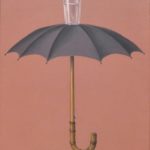 THIS PAINTING began with the question: how to show a glass of water in a painting in such a way that it would not be indifferent? Or whimsical, or arbitrary, or weak – but, allow us to use the word, with genius? (Without false modesty.) I began by drawing many glasses of water, always with a linear mark on the glass. This line, after the 100th or 150th drawing, widened out and finally took the form of an umbrella. The umbrella was then put into the glass, and to conclude, underneath the glass. Which is the exact solution to the initial question: how to paint a glass of water with genius. How would you paint a mysterious glass of water?
THIS PAINTING began with the question: how to show a glass of water in a painting in such a way that it would not be indifferent? Or whimsical, or arbitrary, or weak – but, allow us to use the word, with genius? (Without false modesty.) I began by drawing many glasses of water, always with a linear mark on the glass. This line, after the 100th or 150th drawing, widened out and finally took the form of an umbrella. The umbrella was then put into the glass, and to conclude, underneath the glass. Which is the exact solution to the initial question: how to paint a glass of water with genius. How would you paint a mysterious glass of water? Though the title draws attention to the central green structure, the more captivating element of THIS PAINTING is the gargantuan violin. Casually nestled between two townhouses, the instrument is accompanied by the cloth used to pad a musician’s shoulders, suggesting that a sizable violinist has just performed. Magritte framed the street scene with a fading effect he described as “shading off the image towards the edges,” using arcing lines to produce a memory like haze.
Though the title draws attention to the central green structure, the more captivating element of THIS PAINTING is the gargantuan violin. Casually nestled between two townhouses, the instrument is accompanied by the cloth used to pad a musician’s shoulders, suggesting that a sizable violinist has just performed. Magritte framed the street scene with a fading effect he described as “shading off the image towards the edges,” using arcing lines to produce a memory like haze.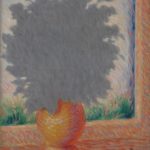 A central element has been mysteriously “erased” from THIS QUASI-IMPRESSIONIST COMPOSITION. As Magritte put it, “The gray patch replaces a bunch of flowers which has disappeared.” Because gray arises from combining pigments, this description suggests that the artist may have first rendered a vibrant bouquet and then obliterated it by over-working the hues directly on the canvas. While this picture is all about effects of painting and color, Magritte explored a similar idea elsewhere with words, representing absent flowers through the syllogism:
A central element has been mysteriously “erased” from THIS QUASI-IMPRESSIONIST COMPOSITION. As Magritte put it, “The gray patch replaces a bunch of flowers which has disappeared.” Because gray arises from combining pigments, this description suggests that the artist may have first rendered a vibrant bouquet and then obliterated it by over-working the hues directly on the canvas. While this picture is all about effects of painting and color, Magritte explored a similar idea elsewhere with words, representing absent flowers through the syllogism:
“The bouquet _______.”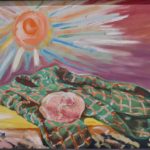 THIS PAINTING brims with artificiality as a radiant sun glares down on an abandoned jacket and slab of ham. The title of the scene, which is set firmly on dry land, seems suited to any muber of these images, evoking the unease of a continent still reeling from war.
THIS PAINTING brims with artificiality as a radiant sun glares down on an abandoned jacket and slab of ham. The title of the scene, which is set firmly on dry land, seems suited to any muber of these images, evoking the unease of a continent still reeling from war.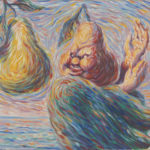 HERE a figure with a pear-shaped head glares at a hanging pear, twisting its torso as if prepared to strike. In addition to its agitation and slapstick humor, the sinister image speaks to the relationship between representation and mimicry. Audiences of Magritte’s time would have recognized the pear head as a derivation of unflattering caricatures of the French king Louis Philippe I (1773-1850). Rendered in sunrise hues, this picture shows the hybrid creature looking disdainfully at the object it resembles, inverting the pun by attacking the idealized fruit rather than the original political target.
HERE a figure with a pear-shaped head glares at a hanging pear, twisting its torso as if prepared to strike. In addition to its agitation and slapstick humor, the sinister image speaks to the relationship between representation and mimicry. Audiences of Magritte’s time would have recognized the pear head as a derivation of unflattering caricatures of the French king Louis Philippe I (1773-1850). Rendered in sunrise hues, this picture shows the hybrid creature looking disdainfully at the object it resembles, inverting the pun by attacking the idealized fruit rather than the original political target.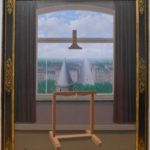 With its titular reference to the ancient Greek mathematician, THIS PAINTING questions the reliability of geometry laws as well as the truthfulness of the art. Here Magritte used the picture-within-picture format to demonstrate how objects that are usually unmistakable in real life can appear nearly indistinguishable in two dimensions, as the rules of linear perspective have flattened a conical tower into the same shape as a receding boulevard. Magritte reportedly experienced this illusion himself as driving, remarking later “how inclined I was to be deceived.”
With its titular reference to the ancient Greek mathematician, THIS PAINTING questions the reliability of geometry laws as well as the truthfulness of the art. Here Magritte used the picture-within-picture format to demonstrate how objects that are usually unmistakable in real life can appear nearly indistinguishable in two dimensions, as the rules of linear perspective have flattened a conical tower into the same shape as a receding boulevard. Magritte reportedly experienced this illusion himself as driving, remarking later “how inclined I was to be deceived.” In Magritte’s later career, he used what he called “the problem of the window” to generate new and intriguing ways of framing paintings within paintings. HERE there is no canvas blocking a view, rather, the vista seen through the lower windowpane is re-created on shards of glass. The picture presents a set of puzzling paradoxes, as the sunset appears to be both inside and outside, painted and actual, present in the past and happening in the present.
In Magritte’s later career, he used what he called “the problem of the window” to generate new and intriguing ways of framing paintings within paintings. HERE there is no canvas blocking a view, rather, the vista seen through the lower windowpane is re-created on shards of glass. The picture presents a set of puzzling paradoxes, as the sunset appears to be both inside and outside, painted and actual, present in the past and happening in the present.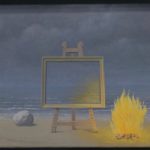 While several works in this gallery appear to perfectly preserve the scenes behind them, THIS PAINTING on the seashore complicates that illusion. Though seemingly transparent on the left side, it looks solid on the right, reflecting the light of the adjacent fire. By disrupting the apparent match between painted surface and what lies beyond, Magritte reminds us that pictures are material objects that can obstruct views as well as elicit imaginative visions.
While several works in this gallery appear to perfectly preserve the scenes behind them, THIS PAINTING on the seashore complicates that illusion. Though seemingly transparent on the left side, it looks solid on the right, reflecting the light of the adjacent fire. By disrupting the apparent match between painted surface and what lies beyond, Magritte reminds us that pictures are material objects that can obstruct views as well as elicit imaginative visions.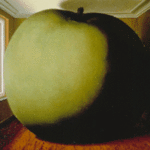 THIS PICTURE features an apple in a pink room with a white ceiling, wooden floors and a white-trimmed window. Light streams in through the window to illuminate the immense apple and create a shadow on the wall. The apple is represented as being large enough to fill the entire room. Or, is it a normal apple in a miniature room?
THIS PICTURE features an apple in a pink room with a white ceiling, wooden floors and a white-trimmed window. Light streams in through the window to illuminate the immense apple and create a shadow on the wall. The apple is represented as being large enough to fill the entire room. Or, is it a normal apple in a miniature room? 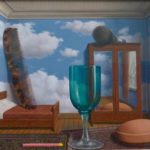 In THIS room of oversized objects, you might wonder how large you would be relative to the comb or the goblet.
In THIS room of oversized objects, you might wonder how large you would be relative to the comb or the goblet.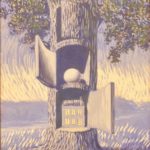 In THIS PICTURE Magritte has imagined a tree as a cabinet with hinged doors that open to reveal a pale sphere and a house in two of its compartments. A hybrid between nature and handicraft, the structure is made more enticing by the topmost door, which the artist painted just ajar, leaving us to wonder what other treasures might lie within. Magritte said of this picture, “The words dictated to us by the blood sometimes appear foreign to us. Here it seems to command us to open up magic recesses in the trees. What would you paint inside the upper tree room?
In THIS PICTURE Magritte has imagined a tree as a cabinet with hinged doors that open to reveal a pale sphere and a house in two of its compartments. A hybrid between nature and handicraft, the structure is made more enticing by the topmost door, which the artist painted just ajar, leaving us to wonder what other treasures might lie within. Magritte said of this picture, “The words dictated to us by the blood sometimes appear foreign to us. Here it seems to command us to open up magic recesses in the trees. What would you paint inside the upper tree room?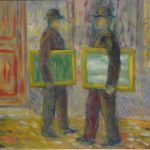 Crystallizing several themes of Magritte’s late career, THIS PICTURE lends its title to this exhibition. Painted in his sunlit surrealist style, the work features canvases within canvases, a favorite device explored in a previous gallery, and men in bowler hats, which would arguably become the artist’s most recognizable motif. HERE two anonymous figures meet in the type of street scene one might associate with impressionist painting. What do you notice about the place in this painting?
Crystallizing several themes of Magritte’s late career, THIS PICTURE lends its title to this exhibition. Painted in his sunlit surrealist style, the work features canvases within canvases, a favorite device explored in a previous gallery, and men in bowler hats, which would arguably become the artist’s most recognizable motif. HERE two anonymous figures meet in the type of street scene one might associate with impressionist painting. What do you notice about the place in this painting?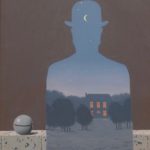 While the silhouetted figure is among the bowler man’s most anonymous incarnations, THIS PAINTING has come to be considered a self portrait of sorts…
While the silhouetted figure is among the bowler man’s most anonymous incarnations, THIS PAINTING has come to be considered a self portrait of sorts…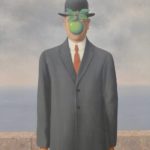 Among Magritte’s most recognizable images, THIS is one of just four oil paintings that the artist identified as self-portrait. While apples appear elsewhere in this exhibition at gargantuan scale, HERE the fruit is life-size but still confounding in its placement. A persistent tension is maintained by our desire to see what is hidden, even as we may imagine that we know who or what is there.
Among Magritte’s most recognizable images, THIS is one of just four oil paintings that the artist identified as self-portrait. While apples appear elsewhere in this exhibition at gargantuan scale, HERE the fruit is life-size but still confounding in its placement. A persistent tension is maintained by our desire to see what is hidden, even as we may imagine that we know who or what is there.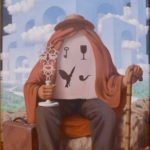 THIS PAINTING shows a faceless, torso-less traveler resting on a journey. Along with his suitcase and cane, the figure carries a more enigmatic item: an enchanting pearl mask with vibrant eyes and lips. Can you find this pearl mask in another painting in the same gallery?
THIS PAINTING shows a faceless, torso-less traveler resting on a journey. Along with his suitcase and cane, the figure carries a more enigmatic item: an enchanting pearl mask with vibrant eyes and lips. Can you find this pearl mask in another painting in the same gallery?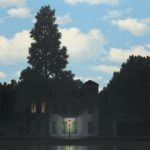 THIS ROOM allows you to step into Magritte’s world, an immersive space showcasing the incredible imagery of Magritte’s most famous residential streets. HERE, Magritte depicts a sleepy residential street, a row of ordinary houses where street lamps glow and light shines through empty windows. What do you notice about the sky?
THIS ROOM allows you to step into Magritte’s world, an immersive space showcasing the incredible imagery of Magritte’s most famous residential streets. HERE, Magritte depicts a sleepy residential street, a row of ordinary houses where street lamps glow and light shines through empty windows. What do you notice about the sky?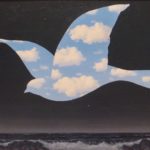 Like Magritte’s Dominion of Light series,THIS PAINTING manifests a duality of day and night, incorporating both a bright blue skyscape and a dark, glistening firmament. His dealer described the subject as a “cut-out bird against a night sky,” but the artist called it simply “the bird of sky.”
Like Magritte’s Dominion of Light series,THIS PAINTING manifests a duality of day and night, incorporating both a bright blue skyscape and a dark, glistening firmament. His dealer described the subject as a “cut-out bird against a night sky,” but the artist called it simply “the bird of sky.”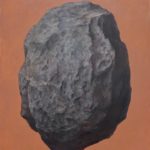 Before it received its current title, THIS PAINTING was simply called The Rock. Do you think this rock is a pebble or a monolith, is small or huge, light or heavy?
Before it received its current title, THIS PAINTING was simply called The Rock. Do you think this rock is a pebble or a monolith, is small or huge, light or heavy?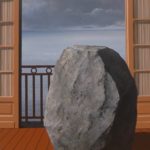 The title of THIS WORK calls attention to that we cannot see.
The title of THIS WORK calls attention to that we cannot see.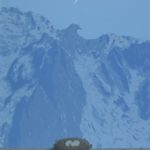 Magritte was often inspired by the 19th century American writer Edgar Allan Pow and even payed a visit to his former home in 1965. THIS PAINTING takes its title from Poe’s story about a wealthy man who crafted and tended to a lush garden estate called Arnheim. Magritte embelished the tale, however, granting the gardener the strength to move mountains so that the sun appears according to his wish. While Poe’s character never actually possessed this power, HERE Magritte adopts a similar ability, painting an eagle with a wingspan that extends into an entire mountain range. Do you notice any motifs that you have seen in previous galleries?
Magritte was often inspired by the 19th century American writer Edgar Allan Pow and even payed a visit to his former home in 1965. THIS PAINTING takes its title from Poe’s story about a wealthy man who crafted and tended to a lush garden estate called Arnheim. Magritte embelished the tale, however, granting the gardener the strength to move mountains so that the sun appears according to his wish. While Poe’s character never actually possessed this power, HERE Magritte adopts a similar ability, painting an eagle with a wingspan that extends into an entire mountain range. Do you notice any motifs that you have seen in previous galleries?
What do you notice in front of the window?
Do you think it shows the real view behind it?
Would you fit in the bed?
Could you lift the bar of soap?
What words or phrases would you use to describe the place depicted in this painting?
If you could enter this space, would you be standing inside or outside? What do you see that makes you say that?
In your mind’s eye, change the scale of one of the objects within this painting. How does that affect your response to the work?
If you were going to make a work called Personal Values, what objects would you choose to depict? Which objects would be big and which objects would be small?
Does the title make sense now?
Do you think the cut-out figure is facing you?
Or is it its back that you are seeing?
Do these pictures capture two fragments of a single day?
Or one instant in a world where land and sky are chronologically disjointed?
What title would you give it?
Is weight a visible property?
Can you paint a voice?
Do you notice any differences in painting the rock and pinstripe floorboards? Why do you think some surface attributes are shown while others are omitted? What does the visible world reveal about the invisible?
ANSWERS
- Les vacances de Hegel (Hegel’s Vacation), 1958
- Image à la maison verte (Image with a Green House), 1944
- L’eclair (Lightning), 1944
- Le mal de mer (Seasickness), 1948
- Le Lyrisme (Lyricism), 1948
- Les promenade des Euclid (Where Euclid Walked), 1955
- Le monde des images, 1950/ca 1962
- La belle captive (The Fair Captive), ca 1950
- La chambre d’écoute (The Listening Room), 1952
- Les valeurs personnelles (Personal Values), 1952
- La voix du sang (Blood Will Tell), 1947
- La cinquième saison (The Fifth Season), 1943
- L’heureux donateur (The Happy Donor), 1966
- Le fils de l’homme (The Son of Man), 1964
- Le libérateur (The Liberator), 1947
- L’empire des lumières (The Dominion of Light), 1954
- Le baiser (The Kiss), 1951
- La voix active (The Active Voice), 1951
- Le monde invisible (The Invisible World), 1954
- Le domaine d’Arnheim (The Domaine of Arnheim), 1962
Private collection
“I… thought that Hegel … would have been very sensitive to this object which has two opposing functions: at the same time not to admit any water (repelling it) and to admit it (containing it). He would have been delighted, I think, or amused (as on a vacation) and I call the painting Hegel’s Holiday.”
Private collection
Musée des Beaux Arts de Charleroi, Belgium
Private collection
Musées royaux des Beaux-Arts de Belgique, Brussels
Private collection
Private collection
The Menil Collection, Houston, TX
Collection SFMOMA
Private collection
Musées royaux des Beaux-Arts de Belgique, Brussels
Musée d’Ixelles, Brussels
Private collection
Los Angeles County Museum of Art
Musées Royaux des Beaux-Arts de Belgique, Brussels
REFERENCES
- Did René Magritte Change His Surrealist Style to Avoid Nazi Persecution?
- Finding the Fifth Season: A User’s Guide to Magritte
- “It’s Like Being in the Picture”: The Dominion of Light at SFMOMA
- Mad or Bad? Magritte’s Artistic Rebellion
- Magritte and Contemporary Art: The Treachery of Images
- Magritte and the Trading of Images
- Matteson Art – René Magritte
- “Of course it’s not a pipe.” The flawless logic behind the paintings of René Magritte
- No Laughing Matter: Magritte’s ‘Fifth Season’ is Beautiful, Serious Stuff
- RENÉ MAGRITTE AT SFMOMA – CECI N’EST PAS MAGRITTE
- René Magritte: The Fifth Season at SFMOMA | SF CIVIC CENTER
- René Magritte: enigmatic master of the impossible dream
- René Magritte still has the power to surprise
- Storm Thorgerson on Magritte
- The best—and worst—of Magritte is on show at SFMoMA
- What René Magritte did When Surrealism was Trumped by ‘Nazi idiots’
- What’s That Cat Doing in Rene Magritte’s Invisible World?
Jeff Koons Muses on Surrealist René Magritte
Art brings you in contact with feeling. When you see a Magritte, you feel something; you have an experience that can be very, very strong. He’s very poetic. One of the beautiful things about his work is that it’s really made for the viewer to participate in. There’s a generosity there—it’s about you and your response to the work. So when you confront a Magritte, it’s not “Oh, Magritte felt this.” It’s really about what you feel and about creating a shared opportunity for you to experience this sensation. It’s not that he wanted to lock himself up in a room to create works for his own experience of these sensations. It’s about the viewer’s perception. It’s about what it means to be human, not what it means to be René Magritte.
https://youtu.be/9OusQZtF-Fc

